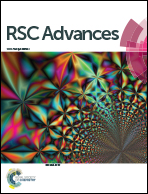N-Methylacetamide as an electrolyte component for suppressing co-intercalation of propylene carbonate in lithium ion batteries
Abstract
N-Methylacetamide (NMA) is used as an electrolyte component to suppress co-intercalation of propylene carbonate (PC) molecules into the graphite anode in lithium ion batteries. From the cyclic voltammetric and charge–discharge properties of graphite in a PC-based electrolyte containing an NMA component, it is found that the addition of the NMA solvent is effective in suppressing co-intercalation and irreversible decomposition of PC solvent. The graphite anode can be effectively cycled in the electrolyte and a first coulombic efficiency of 75.9% is obtained. SEM and EDX studies show that NMA participates in the formation of a solid electrolyte interphase (SEI), which is able to inhibit co-intercalation and irreversible reductive decomposition of PC molecules. Raman spectroscopic investigation reveals that the interaction between Li ions and PC is decreased because Li ions can be preferentially solvated by solvent NMA. When NMA is used as an additive in a PC–ethylene carbonate (EC) co-solvent electrolyte, a first coulombic efficiency of 87.6% is obtained, considerably higher than that of 51.6% obtained in the reference electrolyte. The cycling stability of the graphite electrode is also significantly improved in the NMA-added electrolyte.


 Please wait while we load your content...
Please wait while we load your content...